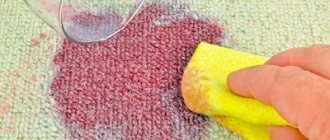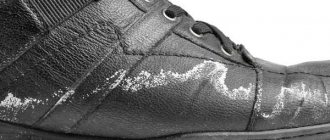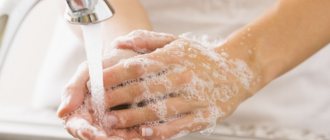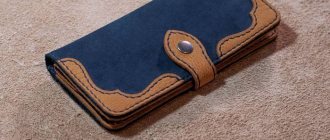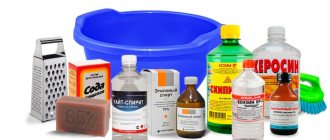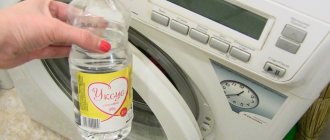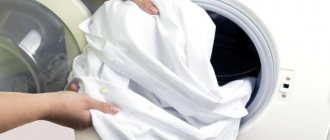Iodine solution is an indispensable pharmaceutical product for treating abrasions and wounds, hematomas and puncture marks. An iodine “mesh” on the chest is an old grandmother’s way of activating the process of phlegm discharge from the bronchi during a cold.
But it’s one thing when traces of iodine appear on the skin for medicinal purposes, and a completely different situation when the spots appeared due to negligence and it is necessary to get rid of them as soon as possible.
We will tell you in this article how and with what you can remove iodine from the skin at home.
What to do first?
Baking soda will help
to clean fresh (just appeared) iodine stains on the skin as quickly as possible . This is a natural alkali that completely dissolves iodine embedded in the skin.
It is necessary to dilute the soda with water to a thick paste, apply the resulting mixture to the stain and leave for fifteen minutes. After the bleaching procedure, wash off the soda with warm water.
Another way to quickly remove fresh traces of iodine is olive oil. Heat 100 ml of olive oil in a water bath . Without allowing the oil to cool, soak a soft cloth (preferably fabric), which is applied to the stain for half an hour.
If you are unable to remove the iodine stain from your skin the first time, you need to take a break and try again using other cleaning products.
Features of removing iodine stains at home
In fact, it is quite possible to get rid of traces of iodine on the body, fabric and other surfaces. You just need to follow the recommendations exactly and not neglect precautions, in particular, be sure to test the stain remover on an inconspicuous area of the material (near the seams, on the inside of the hem). Moreover, even if it is a folk remedy and not a chemical.
Many dry cleaners refuse to accept clothes stained with iodine, arguing that the antiseptic cannot be removed from the fabric.
Iodine is an excellent antiseptic, but stains from it on different surfaces are quite difficult to remove
How to remove fresh stains
There is no significant difference between the fight against old and fresh iodine stains. This is explained by the fact that this antiseptic has a complex structure of the substance and is instantly absorbed into the surface it comes into contact with. But if the mark is already “aged”, it is more difficult to remove it. So, if, upon contact with iodine, you find stains on your clothes, then you need to blot the stain as quickly as possible with a dry cloth, a cotton pad or a piece of bandage - any fabric that has good absorbent abilities.
There is an easy way to remove fresh stains from fabrics - the sun: iodine burns out under the influence of sunlight (it must be summer outside!). This method is not suitable for old stains.
Iodine quickly penetrates into the fabric fibers, so that a fresh stain almost instantly becomes old.
How to remove old stains: general recommendations
The first and most important thing is to minimize the area of distribution of the antiseptic trace. To do this, apply the selected stain remover along the border of the stained area. The process of wiping off the iodine is from the edges to the center to prevent the stain from expanding.
- removing the antiseptic from the fabric must be done from the wrong side, placing a well-absorbing undyed fabric pad under the front surface;
- the item should not be dusty;
- for delicate and synthetic materials, as well as for denim, the use of strong chemicals can be disastrous - the item may acquire a whitish tint or even tear;
- when using chemicals, especially those with a strong odor, wash the product after removing the stain;
- for the convenience of working with contamination, it is better to pull the area with the stain onto the frame using a board, jar or bottle;
- It is convenient to work with a clothes or toothbrush, cotton swabs or sponges;
- the concentration of any stain remover should be increased gradually;
- After each use of a stain remover, the stained area should be rinsed - this makes it easier to evaluate both the result and the condition of the fabric.
If iodine just gets on the fabric, then the stain should be blotted with a well-absorbent cloth.
Traces of iodine cannot be removed by machine washing, even with the addition of a stain remover. Before loading clothes into the machine, you need to treat the stain with a special stain remover. And after that, machine wash using regular powders.
How can I remove traces?
When choosing a method for removing iodine stains, first of all pay attention to natural products that are as safe as possible for the skin:
Fresh lemon juice
Natural skin brightener. It is enough to treat the spots on the face with a cotton swab soaked in lemon juice so that the skin regains its radiant appearance.
Do not overuse pure lemon juice, as prolonged contact with acid can cause burns.
Hydrogen peroxide
A pharmaceutical disinfectant that copes with ingrained iodine stains on the face. A cotton pad, generously moistened with peroxide, is applied to the stain and left for five minutes.
Since peroxide removes the protective fatty layer of the skin along with the stain, cream must be applied to the skin after cleaning.
Chlorhexedine
To remove traces of iodine from the skin, use only a liquid antiseptic of the maximum dosage (1%) .
A cloth napkin is soaked in a solution of Chlorhexidine, which, wrapped several times with a bandage, is applied as a compress to the iodine stain on the skin.
To enhance the effect, the compress can be wrapped in cling film. After five minutes, the compress is removed.
Potatoes (natural starch)
A great way to remove iodine stains from skin. The potatoes are washed (you don’t have to peel them), cut into two parts and the cut is rubbed onto the stain on the skin .
After three to four minutes, you can evaluate the cleaning result. If necessary, repeat the procedure.
Acetylsalicylic acid
Two or three tablets are ground into powder, dissolved in 0.5 tsp. water. A fairly thick paste is applied to traces of iodine and, without rubbing, covered with a cotton pad. After three minutes, the cotton wool is removed and the skin is wiped with a clean, damp sponge.
Handwash
There is another non-standard method for removing traces of iodine from the skin of your hands. We are talking about hand washing . The bleaching components of washing powder do an excellent job not only of dirt on clothes, but also of ingrained iodine stains on hands.
Prolonged contact with the detergent and active rubbing of clothing will help quickly cleanse the skin of brown marks. After hand washing, do not forget to lubricate the skin of your hands with nourishing cream.
How to wash iodine
Iodine is a universal remedy for healing wounds, cuts and insect bites, an excellent disinfectant that is always at hand. Sometimes, when cauterizing a wound, we accidentally stain the skin of our hands, face, clothes, and nearby objects with iodine. It is very problematic to instantly wash away iodine. It is eliminated within a few days. Therefore, in order to immediately get rid of stains, you need to know several sure-fire methods.
1
Hydrogen peroxide
It is in almost every first aid kit. It is enough to moisten cotton wool with a hissing liquid and apply it to the iodine stain on the skin. Hold for five or ten minutes. Peroxide is an excellent bleach and can quickly bleach dark iodine. Afterwards, rinse off with running water.
2
Lemon
If you don’t have hydrogen peroxide in your medicine cabinet, you can safely use lemon, which also discolors such stains. Squeeze out fresh juice. Dip a cotton swab and hold it tightly in the desired place for ten minutes. A combination of lemon and peroxide is possible if both are available. At the end, apply a barely noticeable stain with a rough sponge to improve the result.
3
Alcohol
You can use medical alcohol or perfume that contains it. There are also special wet wipes with alcohol. Apply iodine to the stain and leave for no more than five minutes, because alcohol can dry out the skin. Afterwards, be sure to lubricate with cream.
4
Scrub
An ordinary cosmetic scrub can cleanse the skin of iodine. But if you don’t have it, then you can prepare a mixture with a peeling effect yourself. It is enough to mix honey with salt and massage the area with the stain. Instead of honey, you can add any cleanser that has a glycerin base. At the end of the procedure, apply cream to avoid irritation.
5
Skin cream
Apply any rich cream generously to the area with iodine and leave for an hour. The cream should be absorbed. Rub with a sponge and wash off. The stain will not be wiped off the first time, we repeat the same thing several times. Regular olive oil can be a substitute for the cream.
6
Hot salt bath
The method is especially good if iodine has ended up on various parts of the body, and it will take a very long time to wash it off with ordinary tampons. The easiest way is to take a bath of hot water, dilute salt in it and lie down. High temperature water will significantly soften the skin, which will allow the iodine to be washed off faster. It will not be superfluous to wipe yourself with a washcloth and liquid soap.
7
Washing clothes
The method is suitable if your hands or fingers are stained with iodine. You still can’t escape from doing laundry, so we combine business with pleasure. By hand washing a couple of items with powder, the iodine stain will become less noticeable or disappear altogether. Finally, apply cream to your hands.
8
Removing iodine from objects and things
Drops of iodine on the floor should be wiped with a rag with bleach or a cleaning agent. Clothes stained with iodine can be cleaned with a five percent alcohol solution, as well as raw potatoes. Grind it on a fine grater and apply it to the fabric for half an hour. Grated potatoes also perfectly scrub metal and wooden objects and are suitable for washing off iodine from the table. The most convenient way to clean the kitchen table is with dishwashing detergent or alcohol. Leather furniture should be cleaned with a special stain remover or nail polish remover. If we are unable to deal with iodine using all of the above methods, we buy a solution of sodium hyposulfite at the pharmacy. Apply it to any surface and simply wash off with water.
As it turned out, iodine stains do not remain forever; they can be easily removed from any object, thing or skin. Therefore, you should not refuse to use it and worry about the cleanliness of things. After all, iodine is effective, natural and very beneficial for the body.
sovetclub.ru
How to remove stains from your face?
There are several ways to cleanse delicate facial skin from brown iodine stains:
Fat cream
Iodine stains are generously lubricated with grease and left for five to ten minutes. After the cream has been absorbed, wipe the stain with gentle movements with a soft sponge, and treat the cleaned area of skin with facial tonic.
Laundry soap
An excellent cleanser and antibacterial agent . Suitable for treating delicate facial skin, does not cause allergic reactions.
I rub the soap in my hands until a thick foam appears. Then, carefully, without smearing it over the face, apply the foam to the spots.
As soon as the soap foam dries, it is washed off along with the stains with clean warm water.
Sea salt and bee honey
A pleasant relaxing massage with a scrub of honey and sea salt will not only cleanse the delicate skin of your face of iodine stains, but will also relax you and relieve nervous tension. To prepare the scrub, mix honey and salt (ratio 2:1) in a clean container .
The resulting composition is rubbed into the skin with gentle massaging movements, then removed with a soft damp cloth, and a protective cream is applied to the face.
The skin of the face is delicate and can be easily injured. If, after applying any product, an unpleasant burning sensation, tingling or tightness appears, the cleaning procedure must be stopped immediately and the product rinsed off with warm water.
Methods and means of cleaning
Fresh pigment can be easily washed off with a warm solution with the addition of a detergent. There are other cleaning options.
Iodine removers
There are several effective ways.
| Means | Recommendations |
| Medical alcohol | Moisten a cotton pad and apply it to the plate in a circular motion. If there are wounds on the skin near the treated area, it is advisable not to touch them |
| Alcohol |
ammonia
To achieve the result, toothpaste with a whitening effect, evenly distributed over the stained plate, will help. Wait for the composition to be absorbed, then wash off. The stain will not be completely removed in one go, but will become less noticeable.
Quick Methods
It is possible to erase yellow-brown marks without a trace as soon as the liquid hits the plate. Procrastination complicates the process and makes it lengthy.
The following options will speed up the procedure:
- diluted table vinegar is poured into a small container, fingers are immersed in it for half an hour and removed so that skin irritation does not develop;
- make baths with sea salt (the product is more effective than citric acid);
- dilute a crushed tablet of ascorbic acid in water, keep the stained fingers in the liquid for several minutes.
Stain removers provide quick results. Use chemicals with caution; do not use them on manicures or in the presence of cracks, cuts, or other skin defects.
How to clean nails?
There are several options for solving the problem of iodine-stained nails.
The first option for the laziest is to leave everything as is. Iodine is a volatile substance and sooner or later, under the influence of sunlight, the brown marks will disappear on their own.
The second option for those who cannot wait is to begin the process of removing brown spots from nails as quickly as possible (and the sooner it begins, the greater the chance of completely getting rid of traces of iodine).
A variety of means are used to remove iodine stains from nails:
Medical alcohol is the most effective remedy in the fight against traces of iodine on nails. It is enough to wipe the nail plate with a cotton pad generously moistened with alcohol. It is important to wipe your nails gently so as not to rub brown spots all over your finger.- Toothpaste with a whitening effect will help fade traces of iodine. The nails are covered with a thick layer of paste, left for ten to fifteen minutes, and removed with a soft sponge or cotton sponge.
- Ammonia (diluted with water in a 1:1 ratio). Fingers are immersed in a bath of diluted ammonia for at least twenty minutes. If at the end of this time traces of iodine from the nails have not disappeared, the procedure is repeated again.
The fastest possible result of completely removing iodine stains from the nail plate can be achieved using chemicals. Alternatively, rub the nails with a cotton swab dipped in nail polish remover.
For those who can show off artificially extended nails, iodine staining can be a real problem. The thing is that any aggressive chemical compositions destroy the structure of the artificial coating, making the nail dull and fragile.
The process of removing stains in this case is limited to using the most gentle means (for example, vegetable oil).
Ways to remove traces of iodine from skin
Usually, traces of iodine on the body are unstable and disappear on their own, without the use of any means. If there is a lack of iodine in the body, it is absorbed into the skin within 3 hours. When there is enough of it in the tissues, the drug can be absorbed within 24 hours. Therefore, stains from it do not need to be removed: it will disappear on its own after some time.
However, there are times when it is urgent to get rid of such a trace. In this situation, there are many ways to wash iodine from the skin using improvised means that are found in every home . The most effective means include:
alcohol and alcohol solutions;- sea salt;
- baking soda;
- hydrogen peroxide;
- chlorhexidine;
- laundry soap;
- dishwashing liquid;
- lemon juice or citric acid;
- vegetable oil;
- fat cream;
- nail polish remover;
- acetone;
- Body Scrub.
To clean marks from skin and nails , you should always act the same way:
- Soak a cotton pad, cloth or sponge in the chosen product.
- Rub it on the dirty area.
- Rinse skin under running water.
- Lubricate it with rich cream.
If you don’t know how to remove iodine from your skin, use a time-tested product - alcohol or an alcohol solution. For the body, use only medical alcohol. Technical ethyl alcohol is not suitable for these purposes. Medical alcohol can also be replaced by vodka or any other alcohol solution. These products cause dry skin, so avoid using alcohol on your face and neck. For children, the use of alcohol is also unacceptable.
How to treat iodine burns at home?
Prolonged contact of iodine with the skin, application of a pharmaceutical product to the same area of the skin without a temporary break, can cause iodine burns.
A signal that the skin has suffered from improper use of iodine will be severe redness and burning of the previously treated area. After twenty-four hours, the burn site begins to peel off (a thin layer of damaged epithelium peels off).
Correct first aid actions will help to minimize the manifestations of iodine burns on the skin
the burn site is washed with plenty of water, the ideal option is running cool tap water; the burn must be washed for at least half an hour;- the burn is treated with menthol toothpaste or tooth powder diluted with water (toothpaste neutralizes the effect of iodine);
- a blister that appears at the site of a burn is covered with grated fresh potato gruel or tea leaves - such actions help to temporarily relieve pain.
Under no circumstances should the blister be punctured (there is a high risk of bacterial infection).
After first aid has been provided, an iodine burn must be shown to a doctor. The specialist will assess the extent of skin damage and prescribe the necessary, adequate treatment.
Most often, therapy consists of:
- treating burns with antiseptic, wound-healing ointments (Levomekol, Bepanten),
- taking painkillers and decongestants.
How to remove iodine stains from carpet and sofa
If antiseptic gets on the carpet or sofa, you can use:
- stain remover (the application regimen is usually indicated in the instructions for the product);
- soda and vinegar (prepare and apply in the same way as when working with fabrics).
In addition, you can use starch, from which a special gruel is prepared:
- Dilute the starch with water to the consistency of sour cream.
- Apply to the stained area and leave for 15 minutes.
- Remove the remaining slurry with cold water.
If we are removing a stain from a carpet, we must finally vacuum it.
To clean sofas and carpets, you can use ammonia in the same way as for removing stains from fabrics, being sure to ventilate the room well after treatment.
You can rub the iodine stain remover into the fabric using a brush.
How to cleanse your skin with hydrogen peroxide
Hydrogen peroxide works well to remove traces of iodine from the skin. If we are talking about colored leather, then before exposure to the chemical the fabric must be soaped so as not to discolor the coating, and also to prevent the stain from spreading.
- Soak a cotton pad in hydrogen peroxide.
- Wipe the stain.
- Rinse with cool water.
If peroxide does not help, then you can use acetic acid. The application technology will be the same.
It is impossible to predict the effect of any stain remover on leatherette. This depends on the quality of the material, workmanship and a number of other factors related to production technology.
After removing the stain, the leather surfaces are wiped with soapy water.
How to remove iodine stains from fair skin with boric acid
The area of contamination must be wiped with a cotton pad soaked in the solution, and then wiped with clean water. The method is suitable for removing stains from light skin.
Boric acid does a good job of removing iodine stains from light skin.
How to clean a table, cabinet, linoleum and other hard surfaces
The fastest and most effective way to remove traces of antiseptic from furniture (countertops, cabinets, refrigerators), flooring (laminate, linoleum, parquet) is to use acetylsalicylic acid, that is, aspirin.
The same method is also suitable for removing iodine stains from umbrellas.
- Dissolve an aspirin tablet in 2/3 tbsp. water.
- Moisten cotton wool or a soft cloth with the solution and rub into the surface.
- Remove residues with warm water.
If iodine gets on light-colored plastic, the stain can be wiped off with a cotton pad soaked in hydrogen peroxide or nail polish remover.
Iodine can be removed from hard surfaces using aspirin.
